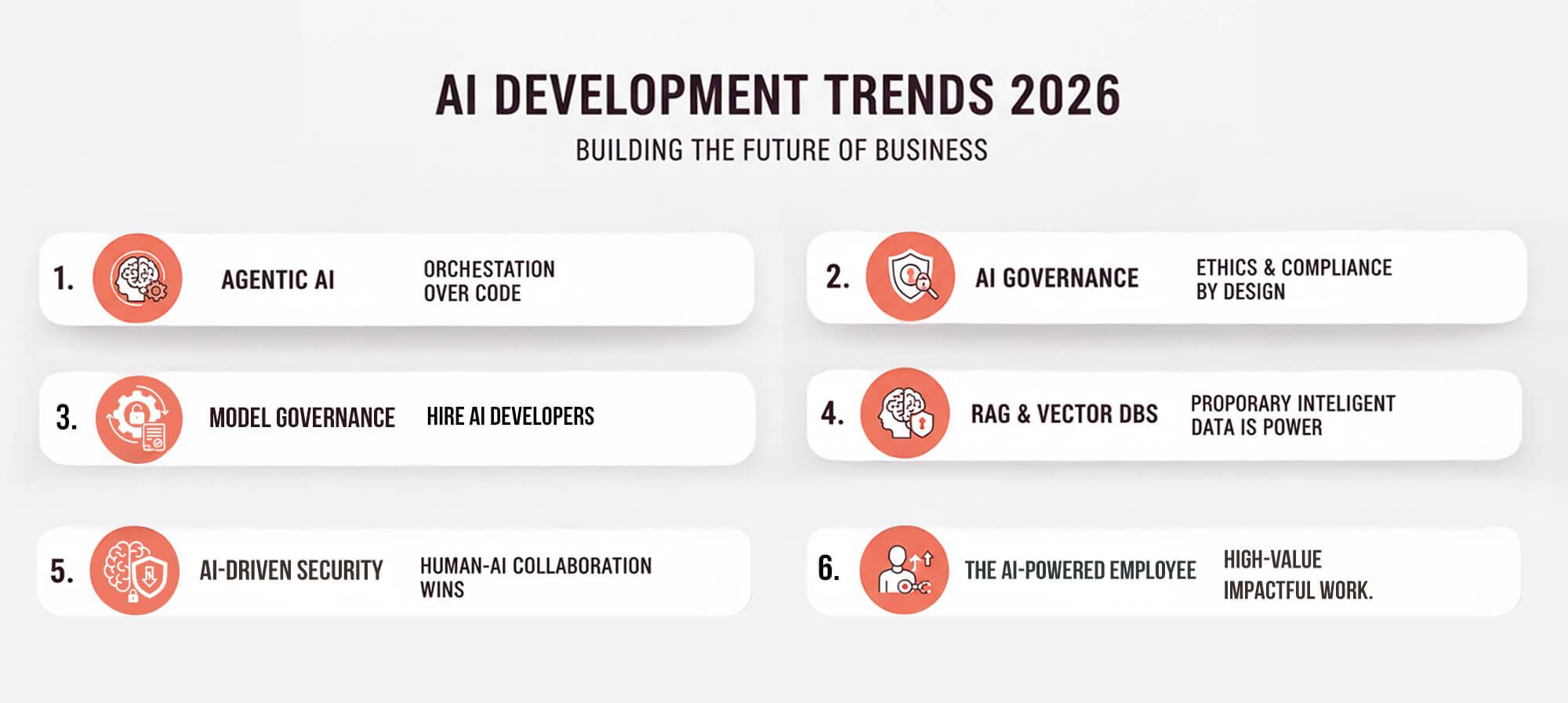Top AI Developer and AI Development Trends for 2026
For tech founders, the challenge is clear: how do you move beyond experimenting with AI tools and build a sustainable, competitive AI-driven future?
This requires a strategic understanding of the shifts happening in development, and critically, a complete overhaul of your talent acquisition strategy. By 2026, the future of your product and your profit margin will depend on human-AI collaboration and a global mindset.
Here are the critical trends every founder must master to stay ahead.
The Great Talent Shift: Why Geography is Now the AI Barrier
The single most important decision for an AI-centric company in 2026 is where they source their talent.
Trend 1: The End of Local Hiring for Specialized AI Roles
The demand for specialized AI Developers, engineers skilled in MLOps, vector databases, and agentic systems, has caused an unsustainable salary inflation in traditional tech hubs. Founders face a zero-sum game: pay astronomical local salaries that drain runway, or compromise on quality and lose the AI race.
The Solution: Global Remote Talent. Forward-thinking founders are bypassing this bottleneck by committing to hiring remote developers across the globe. This isn’t just about cost-cutting; it’s about accessing specialized expertise that simply doesn’t exist in one city. Whether you need an ML expert from Eastern Europe or a Natural Language Processing (NLP) engineer from Latin America, eDev makes this global talent pool available, vetted, and ready to integrate. Limiting your search to a certain radius is like limiting your AI potential.
The Technology Trends Shaping Your 2026 Roadmap
Beyond talent acquisition, the architecture of innovation is changing in fundamental ways.
Trend 2: The Agentic Revolution and Orchestration Over Code
AI is moving beyond simple code generation to autonomous Agentic AI. These are systems capable of executing multi-step workflows, setting their own sub-goals, and self-correcting errors (e.g., an agent autonomously managing an entire customer support lifecycle).
- Founder Insight: You need developers focused on orchestration, not just coding. The value shifts to designing robust AI frameworks (using tools like LangChain) that manage memory, tool-use, and context for these autonomous agents.
Trend 3: Model Governance and Regulation as a Core Feature
With landmark legislation like the EU’s AI Act, AI Governance is no longer an optional compliance burden; it’s a necessary engineering feature. Companies must be able to explain, audit, and prove their models are unbiased and ethical.
- Founder Insight: Every AI feature must be built with Explainable AI (XAI) principles. This drives the need to hire AI Developers who understand how to build auditable pipelines, not just consume black-box APIs.
Trend 4: RAG and Vector Databases as the New Data Standard
Retrieval-Augmented Generation (RAG) is the key to enterprise AI. It grounds Large Language Models (LLMs) in your proprietary, internal data (financial reports, private codebases, user manuals), ensuring answers are accurate and relevant, eliminating hallucinations.
- Founder Insight: To implement RAG effectively, you must master Vector Databases. Your AI Developer team needs to be proficient in vector embeddings and Approximate Nearest Neighbor (ANN) search, as these databases are fast becoming the default data layer for all context-aware applications.
Trend 5: AI-Driven Security and Threat Modeling
As AI permeates the stack, it both creates new vulnerabilities (prompt injection attacks) and offers the most effective defense. AI will be used to analyze network traffic patterns, predict and model human-like attack behaviors, and automate immediate response actions faster than human security teams.
- Founder Insight: Prioritize AI-driven cybersecurity development. Hiring developers with a background in both AI and security engineering is a rapidly emerging necessity.
Trend 6: The AI-Powered Employee (Augmentation over Replacement)
The focus is shifting from automating entire jobs to augmenting nearly every employee function. The IBM Institute for Business Value reports that 87% of executives believe employees are more likely to be augmented than replaced by generative AI, freeing employees to focus on high-value, impactful work.

The Human-AI Collaboration Imperative: The True Story of Reallocation
The most profound trend of 2026 is the reality of the hybrid workforce. Initial fears that AI would lead to massive, permanent job destruction are giving way to a more nuanced reality: AI replaces tasks, not entire jobs.
The IBM Case Study: The Reallocation Model
In 2023, IBM rolled out its proprietary AI platform, AskHR, to automate routine administrative functions. The move initially led to layoffs in back-office roles. However, the subsequent workforce activity confirmed a critical pivot:
- Automation Success: AskHR automated approximately 94% of routine HR tasks, achieving reported productivity gains in the billions.
- The Rehire Reality: Despite the initial cuts, IBM’s overall workforce grew. CEO Arvind Krishna confirmed in statements to The Wall Street Journal that the operational savings freed up investment to hire new specialists in high-touch, non-automatable areas like software engineering, sales, and specialized marketing (Source: IBM CEO: Layoffs Due to AI Led to ‘More Investment’ in Other Roles ). The net effect was a reallocation of talent, not a net loss of jobs. This transformation is underscored by the observation that 4 out of 5 executives surveyed by the IBM Institute for Business Value expect generative AI to change employee roles and skills [Source: The augmented workforce for an automated, AI-driven world | IBM].
This case validates the Human-AI Collaboration Model: AI eliminated friction and cost in routine tasks, allowing the company to strategically reinvest those resources into roles requiring human creativity, strategic judgment, and empathy.
Conclusion: Your Future is Hybrid and Global
The path to success in 2026 is clear: Embrace AI to eliminate organizational friction, but retain and expand human talent for strategic growth. This requires a shift in mindset:
- AI is an Investment Multiplier, not a Cost Cutter. Use it to free capital for strategic, high-value human roles.
- The Talent War is Over—If You Go Global. Break free from local salary wars and tap into the worldwide pool of specialized AI Developers ready to build your future remotely.
Don’t wait for your competitors to master these trends. Start building your AI-driven, hybrid, and global team today.
Ready to find the specialized AI talent needed to execute these trends? Contact us today.





























